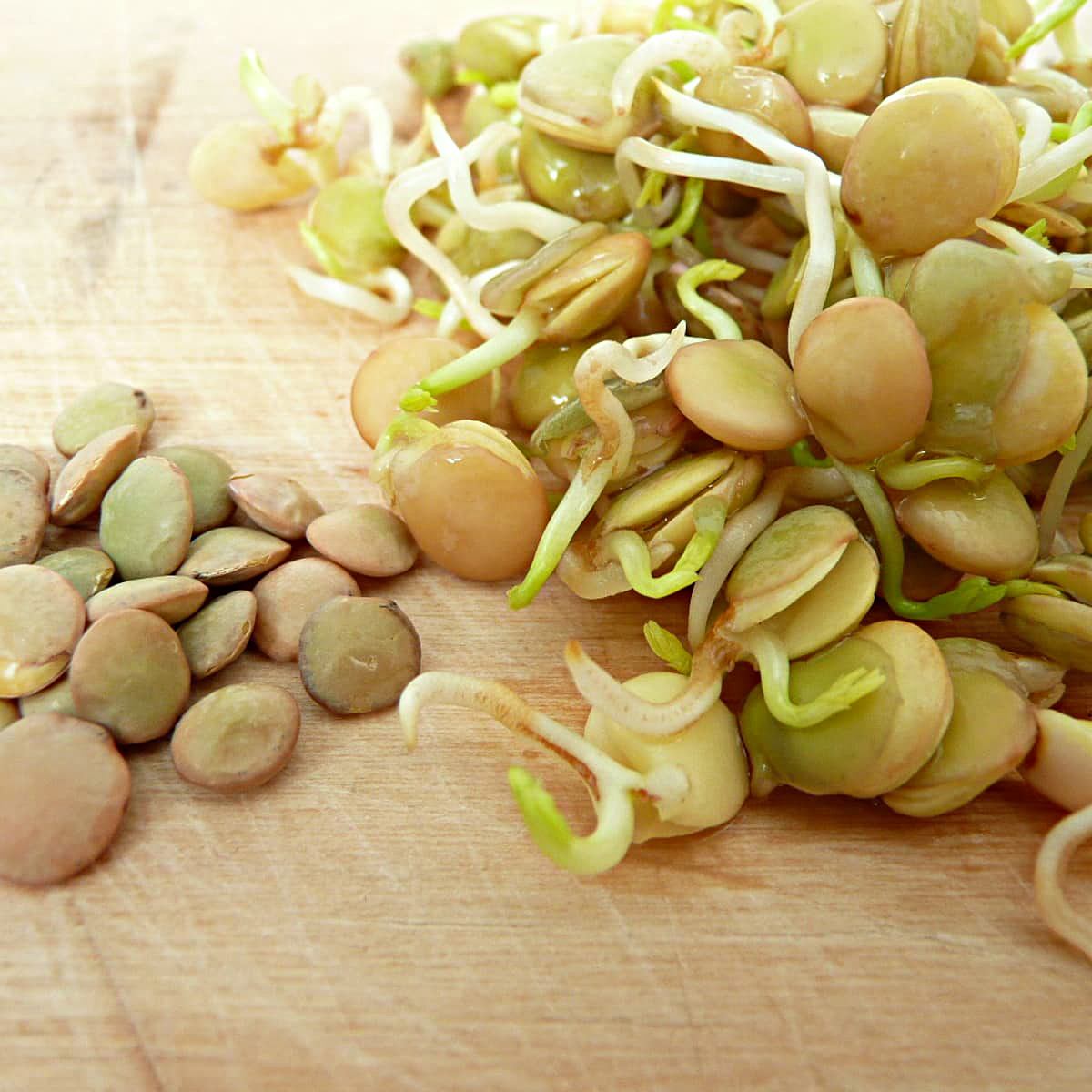

Articles
How To Store Lentils
Modified: February 20, 2024
Learn the best tips and techniques for storing lentils in this informative article. Keep your lentils fresh and flavorful for longer with our expert advice.
(Many of the links in this article redirect to a specific reviewed product. Your purchase of these products through affiliate links helps to generate commission for Storables.com, at no extra cost. Learn more)
Introduction
Lentils are commonly known as a staple food in many cultures around the world. These small legumes are not only versatile in the kitchen, but they also offer numerous health benefits. Whether you’re a lentil lover or just starting to incorporate them into your diet, it’s crucial to know how to store them properly to maintain their freshness and taste.
In this article, we’ll explore the different types of lentils, discuss the benefits they offer, and provide you with valuable tips on how to store them effectively. Whether you prefer to stock up on lentils for long-term storage or need guidance on storing cooked lentils for future use, we’ve got you covered.
So, let’s dive in and discover how to keep your lentils fresh and flavorful for as long as possible!
Key Takeaways:
- Proper storage of lentils is crucial to maintain their freshness and nutritional value. From choosing the right container to checking for freshness, following the correct storage techniques ensures a readily available supply for delicious and nutritious meals.
- Understanding the benefits and types of lentils, along with proper storage methods, allows you to enjoy their versatility and health benefits for an extended period. Whether in the pantry or freezer, properly stored lentils are always ready for your culinary creations.
Read more: How To Store Sprouted Lentils
Benefits of Lentils
Lentils are not only delicious but also packed with essential nutrients that can contribute to your overall health and well-being. Here are some of the key benefits that lentils have to offer:
- Rich in Fiber: Lentils are an excellent source of dietary fiber, which is beneficial for digestion and can help regulate blood sugar levels.
- High in Protein: Lentils are a great plant-based protein source, making them an ideal choice for vegans and vegetarians. They contain amino acids that are important for building and repairing tissues.
- Nutrient-Dense: Lentils are loaded with essential vitamins and minerals such as folate, iron, potassium, and magnesium. These nutrients support various bodily functions and help promote optimal health.
- Heart-Healthy: Lentils are low in fat and high in soluble fiber, which can help lower cholesterol levels and reduce the risk of heart diseases.
- Weight Management: Lentils have a high satiety factor, meaning they make you feel satisfied and full for longer periods, aiding in weight management and controlling cravings.
- Digestive Health: The fiber content in lentils promotes a healthy digestive system by preventing constipation and supporting the growth of beneficial gut bacteria.
- Regulates Blood Sugar: Lentils have a low glycemic index, making them suitable for individuals with diabetes or those looking to manage their blood sugar levels.
- Boosts Energy: Lentils are a great source of carbohydrates and provide a steady release of energy, making them an excellent choice for athletes and those leading an active lifestyle.
With these incredible benefits, incorporating lentils into your diet can be a nutritious and tasty way to support your overall health.
Types of Lentils
Lentils come in various colors and sizes, each with its unique flavor and texture. Here are some of the most commonly found types of lentils:
- Green Lentils: Green lentils have a robust flavor and a firm texture, making them ideal for salads, soups, and side dishes. They hold their shape well when cooked and offer a slightly nutty taste.
- Brown Lentils: Brown lentils are the most commonly available type. They have a mild, earthy flavor and a tender texture. Brown lentils are versatile and work well in stews, curries, and hearty dishes.
- Red Lentils: Red lentils are known for their bright orange color. They cook quickly and have a creamy texture when cooked, making them perfect for dals, purees, and soups.
- Yellow Lentils: Yellow lentils, also known as split peas, are split and peeled versions of red or green lentils. They cook quickly and have a smooth texture. Yellow lentils are commonly used in Indian and Middle Eastern cuisines.
- French Lentils: French lentils, also called Puy lentils, are smaller and darker than other lentils. They have a robust flavor and hold their shape well when cooked, making them a great choice for salads and side dishes.
- Black Lentils: Black lentils, also known as beluga lentils due to their resemblance to caviar, have a rich flavor and a slightly firmer texture than other lentils. They work well in salads, soups, and side dishes.
Each type of lentil has its own unique taste and texture, allowing you to experiment with different recipes and flavors in your culinary adventures.
Proper Storage Temperature
The proper storage temperature is crucial to maintain the freshness and quality of lentils. Ideally, lentils should be stored in a cool and dry place, away from direct sunlight and moisture. The optimal storage temperature for lentils is around 40°F to 60°F (4°C to 15°C).
If you live in a hot and humid climate, it’s best to store lentils in the refrigerator to prevent them from spoiling quickly. However, keep in mind that refrigeration may cause the lentils to absorb moisture, so make sure they are stored in an airtight container to minimize humidity exposure.
It’s important to note that extreme temperature fluctuations can affect the quality of lentils. Avoid exposing them to sudden changes in temperature, such as placing them directly in a hot kitchen after taking them out from the refrigerator. This can lead to condensation and spoilage.
In summary, store lentils in a cool and dry place with a stable temperature to ensure their freshness and longevity.
Choosing the Right Storage Container
When it comes to storing lentils, selecting the right storage container is essential to keep them fresh and protect them from moisture, pests, and contamination. Here are some factors to consider when choosing a storage container:
- Airtightness: Opt for containers that have a tight seal to prevent air and moisture from entering. This will help maintain the quality and freshness of the lentils for a longer period.
- Material: Choose containers made of food-grade materials such as glass, BPA-free plastic, or stainless steel. These materials are non-reactive and will not leach harmful chemicals into your lentils.
- Size: Consider the amount of lentils you will be storing and choose a container that can comfortably accommodate your needs. It’s better to have a slightly larger container than a cramped one, as it allows for better circulation and easier access.
- Transparency: Clear containers are beneficial as they allow you to easily see the contents without having to open the container. This helps you quickly identify the lentil type and quantity remaining.
- Protection from Light: Lentils can be sensitive to light, so consider using opaque containers or storing them in a dark pantry to minimize exposure to sunlight.
- Pest Resistance: Choose containers that are pest-proof or pest-resistant. Look for containers with a secure lid design that can prevent bugs, insects, or rodents from accessing your lentils.
It’s important to clean the storage container thoroughly before using it for lentils. Wash it with mild soap and warm water, rinse well, and allow it to dry completely before filling it with lentils.
By selecting the right storage container, you can ensure that your lentils remain fresh, protected, and ready for future use.
Read more: How To Store Cooked Lentils
Preparing Lentils for Storage
Before storing lentils, it’s essential to properly prepare them to ensure their longevity and quality. Follow these steps to prepare lentils for storage:
- Sort and Remove Debris: Spread the lentils on a clean surface and remove any debris, such as stones or foreign particles. This step helps prevent any unwanted elements from contaminating your lentils.
- Rinse Thoroughly: Rinse the lentils under cool running water to remove any dust or impurities. Use a fine-mesh sieve or colander for efficient rinsing.
- Inspect for Discolored or Damaged Lentils: Check each lentil for discoloration, mold, or any signs of spoilage. Discard any lentils that appear damaged or discolored, as they can affect the quality of the stored lentils.
- Dry Completely: After rinsing, spread the lentils on a clean towel or paper towel to dry completely. Make sure all excess moisture is removed, as moisture can lead to mold growth and spoilage.
- Optional: Soak Lentils (Certain Types Only): Some lentils, such as whole green or brown lentils, can benefit from soaking for a few hours before cooking. Soaking helps reduce cooking time and improves digestibility. If you prefer to soak lentils before cooking, do so before storing them.
Once the lentils are properly sorted, rinsed, and dried, they are ready for storage. Remember to use them within their recommended shelf life for optimal freshness.
Properly preparing lentils for storage ensures that you start with clean and high-quality legumes, ready to be used in your favorite recipes when the time comes.
Store lentils in an airtight container in a cool, dry place away from direct sunlight. This will help to preserve their freshness and prevent them from spoiling.
Storing Lentils in the Pantry
Storing lentils in the pantry is a convenient option for easy access and quick meal preparation. Follow these steps to store lentils in your pantry:
- Transfer to Airtight Containers: Transfer the properly prepared lentils into airtight containers. This ensures they are well protected from air, moisture, and pests. Glass jars with tight-fitting lids or food-grade plastic containers with secure seals are suitable options.
- Label and Date: It’s important to label the containers with the type and date of storage. This way, you can easily identify them and use them within their recommended shelf life.
- Store in a Cool, Dark Place: Place the sealed containers of lentils in a cool and dark area of your pantry. Avoid direct sunlight and any sources of heat, as exposure to light and temperature fluctuations can compromise the quality and flavor of the lentils.
- Keep Away from Strong Odors: Lentils have a tendency to absorb odors, so it’s crucial to store them away from strong-smelling spices, herbs, or other pungent food items.
- Periodic Check: Regularly inspect the lentils stored in the pantry for any signs of spoilage, such as mold or off odors. If you notice any issues, discard them immediately to prevent contamination.
When stored properly in airtight containers in a cool and dark pantry, lentils can maintain their quality for up to a year. However, it’s best to use them within six to twelve months for the best taste and texture.
Storing lentils in the pantry provides easy access and ensures that they are readily available for your favorite lentil-based recipes whenever you need them!
Storing Lentils in the Freezer
If you want to extend the shelf life of your lentils, storing them in the freezer is a great option. Freezing lentils can help preserve their freshness and nutritional value. Here’s how to store lentils in the freezer effectively:
- Cool and Pack: Allow the cooked lentils to cool completely before packing them for freezing. If you’re freezing uncooked lentils, there’s no need to cook them beforehand.
- Portion into Freezer Bags or Containers: Divide the lentils into convenient portions that you would typically use for a recipe. This makes it easier to thaw and use only the amount you need without having to defrost the entire batch.
- Airtight Packing: Place the lentils in airtight freezer bags or freezer-safe containers. Squeeze out any excess air from the bags before sealing them to minimize the risk of freezer burn.
- Label and Date: Clearly label the containers or bags with the contents and the date of freezing. This will help you keep track of the lentils and ensure you use them within a reasonable time frame.
- Freeze in Flat Layers: Lay the bags or containers flat in the freezer initially. This allows for faster freezing and easier stacking or storage in the freezer once they are fully frozen. Once frozen, you can stack them vertically for efficient use of freezer space.
Frozen lentils can typically be stored for up to six months without significant loss of quality. However, for the best flavor and texture, aim to use them within three to four months.
When you’re ready to use the frozen lentils, simply thaw them in the refrigerator overnight or place them under running water until fully thawed. Use them in your favorite recipes as you would with freshly cooked lentils.
By storing lentils in the freezer, you can ensure that you always have a convenient supply of ready-to-use lentils on hand, making meal preparation a breeze.
Storing Cooked Lentils
If you have leftover cooked lentils and want to store them for later use, follow these guidelines to keep them fresh and safe:
- Cool the Lentils: Allow the cooked lentils to cool down completely before storing. Leaving them at room temperature for about an hour is usually sufficient.
- Portion into Containers: Divide the cooked lentils into individual portion-sized airtight containers or resealable freezer bags. This way, you can easily thaw and use only the amount you need without defrosting the entire batch.
- Seal and Label: Ensure that the containers or bags are properly sealed to prevent air and moisture from entering. Label them with the date of cooking and contents for easy identification.
- Refrigerate or Freeze: If you plan to use the cooked lentils within a few days, store them in the refrigerator. They can typically be kept for up to 3-4 days. For longer-term storage, freeze them following the instructions mentioned earlier.
- Thaw and Reheat: When you’re ready to use the stored cooked lentils, thaw them in the refrigerator overnight if frozen or remove them from the refrigerator if stored there. Reheat them in a microwave-safe dish or on the stovetop until heated through before incorporating them into your recipes.
- Use within Recommended Timeframe: Cooked lentils should be used within the recommended timeframe to ensure freshness and maintain their quality. Discard any lentils that show signs of spoilage, such as an off odor or mold growth.
Properly storing cooked lentils allows you to make the most of your leftovers and enjoy the convenience of having cooked lentils ready for use in various recipes.
Whether it’s in the fridge or freezer, storing cooked lentils properly ensures that you can enjoy their nutritional value and delicious taste even after they have been cooked.
Read more: How To Cook Lentils On Stove Top
Checking Lentils for Freshness
Checking the freshness of lentils is important to ensure that they are safe to consume and will deliver the best flavor and texture. Here are a few ways to assess the freshness of lentils:
- Visual Inspection: Examine lentils for any signs of discoloration, mold, or unusual spots. Fresh lentils should have a uniform color and appearance.
- Scent Test: Sniff the lentils to detect any foul or unpleasant odors. Fresh lentils should have a mild aroma. If you notice any off smells, it could be an indication that the lentils are spoiled.
- Tactile Examination: Take a handful of lentils and run them through your fingers. They should feel dry, smooth, and without clumps. If you notice any stickiness, dampness, or clumping, it could be a sign of moisture or spoilage.
- Taste Test (Optional): If you’re unsure about the freshness of lentils, you can cook a small sample and taste it. Fresh lentils have a pleasant, earthy flavor. If the lentils taste sour or bitter, it’s best to discard them.
- Check for Weevils: Weevils are small beetles that can infest stored lentils. Inspect the lentils for small holes or signs of insect activity. If you notice any weevils or their larvae, discard the lentils to prevent contamination.
It’s important to note that lentils can have a long shelf life if stored and handled properly. However, it’s always a good practice to check their freshness before using them, especially if they have been stored for an extended period.
If at any point you have doubts about the freshness or safety of the lentils, it is better to err on the side of caution and discard them to avoid any potential health risks.
Summary and Conclusion
Storing lentils properly is essential to preserve their freshness, flavor, and nutritional value. Whether you have dry lentils or cooked lentils, following the right storage techniques will help prevent spoilage and ensure that you can enjoy them for an extended period.
Here’s a quick recap of the important points we covered:
We explored the various benefits of lentils, from their high fiber and protein content to their nutrient density and heart-healthy properties. Lentils are a versatile and nutritious addition to your diet.
We discussed the different types of lentils, each with its unique flavor and texture, such as green, brown, red, yellow, French, and black lentils. Understanding the differences between them can help you choose the best lentil variety for your recipes.
We emphasized the importance of storing lentils in the appropriate conditions. Lentils should be kept in a cool, dry place, away from direct sunlight, and within the optimal temperature range of 40°F to 60°F (4°C to 15°C).
We highlighted the significance of choosing the right storage containers, preferably airtight and made of food-grade materials. Properly preparing lentils by sorting, rinsing, and drying them ensures their cleanliness and removes any potential contaminants.
For long-term storage, we discussed the options of storing lentils in the pantry or freezer. When storing cooked lentils, portioning them and using airtight containers or freezer bags can help maintain their quality.
We also covered how to check lentils for freshness, including visual inspection, scent test, tactile examination, and taste test. And we highlighted the importance of being vigilant for signs of pest infestation, such as weevils.
In conclusion, with the right storage techniques, you can extend the shelf life of lentils and have a readily available supply to enhance your meals. Whether you enjoy a hearty lentil soup, a tangy lentil salad, or a comforting lentil curry, properly stored lentils will always be on hand, ready to be cooked and savored.
So, next time you stock up on lentils, remember these tips to ensure their freshness and enjoy the incredible benefits of this humble legume.
Frequently Asked Questions about How To Store Lentils
Was this page helpful?
At Storables.com, we guarantee accurate and reliable information. Our content, validated by Expert Board Contributors, is crafted following stringent Editorial Policies. We're committed to providing you with well-researched, expert-backed insights for all your informational needs.














0 thoughts on “How To Store Lentils”